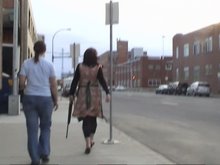This year’s Visualeyez Festival took as its thematic the notion of the city, which became a departure point for performance works challenging habitual assumptions and perceptions of how bodies encounter urban landscapes. In particular, many artists sought to challenge the idea of utilizing the urban setting as a stage or proscenium to be encountered by a festival audience. The performances exhibited a tendency to augment and generate systems and relations flowing within networks already present in the city. In this sense, many of the works created mutually parasitic relations, adding to the various urban systems without destroying them. Most of the works sought to leave little disruption and did not explicitly embrace overt political tactics.
The parasitic relation differs from the expected performer/audience or performance/site relation in that it doesn’t function independent of its host. For example, Nicole Fournier’s guerrilla gardening was playful and unobtrusive as we planted green spaces in abandoned lots and harvested plants from a parking lot. Amber’s strategic appropriation of the marketing iconography on Whyte Avenue to legitimize her “Amber” product line, was similarly playful. Lori Weidenhammer’s quasi-educational performance about the plight of the disappearing honey bee and Colony Collapse Disorder was surprisingly informative as it was meditative. None of these works can be distinguished from the already existent urban network in which they are presented, confusing an expected distinction between artist/audience or stage/artist. These works operate in symbiotic relation, mutually enhancing systems through dynamic exchange that cannot be reduced to cause and effect.
What makes these interventions interesting is that they question their own mode of display and function, as much as they created modes of experiencing and perceiving the city. In other words, these interventions are also operating as forms of research into strategies for developing new relations between audience and performer/artist. The tension between the expectations and conventions of artistic and cultural production are felt in the official promotion and schedule that outlines times and locations for public audiences to attend and see performance art. But in reality, audiences often were frustrated by the fact that there was nothing to see, as performances were nomadic and at times difficult to distinguish from regular occurrences. It was the accidental audience, or passersby, who often experienced the performance---but did not know it to be such. For the artists, this accidental encounter was often the most successful. Other times, the artists themselves were the main audience for the work.
Many of the artists explicitly articulated a desire to erase the ‘stage’ of performance and challenge the audience/performer relation by becoming imperceptible as performers. (This is articulated particularly in the works of Emma Waultraud Howes, Marc Couroux and Juliana Pivato, and Sara Wookey). In this way, becoming imperceptible can be seen as an extension of a parasitic relationship, where imperceptibility follows from indistinguishable separation between site and event. However, the artists’ desire to become imperceptible was subverted by the festival program schedule that listed locations, times and dates for festival audiences to attend works. The assumption that the artist/performer must be physically present during “the performance” still continues as a conventional trope in many performance art festivals and is often expected by festival audiences. This assumption is embedded in an ideology that privileges an ontological framing of performance and the physical body (championed by Peggy Phelan in the 80’s) based on notions of temporal presence. Phelan’s ontology of performance work links the work’s existence to the presence of artist and audience in the “same” temporal frame and geographical space when in fact many encounters with performance may occur through the document, as argued by Auslander. Many of the festival artists expressed the need to both create and experience the zone of indiscernability, where time and space are not fixed. This is a zone where perception is vague—the audience and performer’s roles are not formed - and things are (as noted in the intro) openly sociable: not gridlocked.
One of the issues raised in discussion with the artists was the problematic expectation that the artist’s intention match the project’s realization. Often this is the criteria by which performance and other art works are evaluated. In current discussions in the art conservation and documentation communities, the artist’s intention is often used as the benchmark by which to preserve works. The reality is that often in artistic production (as well as in documentation and conservation) the intention is often not realized in the work: something else happens. When enacting performance in the city, something else must inform the work beyond what was planned. Amber Landgraff explicitly worked with this as a conceptual premise in her work—knowing that philanthropic gestures are not always realized in practice, despite these ‘best’ of intentions. Sometimes the realization supersedes the intention. Indeed, in blogging a record of these events, something different from the artists intentions or the performance event occurs.
The festival blog, a form of urban digital sprawl itself, in some cases superseded its intention to document. Many of the performance works will be experienced by a larger audience and over a greater duration of time than the works were through the live encounter. Festival artists are aware of this fact, and many expressed an interest in this platform as an extension of their performances as self-reflective research. The performance documents, as seen in the parasitic blogs and comments reflect the processual quality of the projects. In this sense, the documentation process is utilized as a platform for processual performances. There is not the sense that the performances are finished but in the process of becoming—and this is the very quality that lends to the dynamic of research and creation or performance research.
Sunday, June 10, 2007
Subscribe to:
Posts (Atom)


